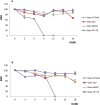Compatible bacterial mixture, tolerant to desiccation, improves maize plant growth
- PMID: 29117218
- PMCID: PMC5678714
- DOI: 10.1371/journal.pone.0187913
Compatible bacterial mixture, tolerant to desiccation, improves maize plant growth
Abstract
Plant growth-promoting rhizobacteria (PGPR) increase plant growth and crop productivity. The inoculation of plants with a bacterial mixture (consortium) apparently provides greater benefits to plant growth than inoculation with a single bacterial strain. In the present work, a bacterial consortium was formulated containing four compatible and desiccation-tolerant strains with potential as PGPR. The formulation had one moderately (Pseudomonas putida KT2440) and three highly desiccation-tolerant (Sphingomonas sp. OF178, Azospirillum brasilense Sp7 and Acinetobacter sp. EMM02) strains. The four bacterial strains were able to adhere to seeds and colonize the rhizosphere of plants when applied in both mono-inoculation and multi-inoculation treatments, showing that they can also coexist without antagonistic effects in association with plants. The effects of the bacterial consortium on the growth of blue maize were evaluated. Seeds inoculated with either individual bacterial strains or the bacterial consortium were subjected to two experimental conditions before sowing: normal hydration or desiccation. In general, inoculation with the bacterial consortium increased the shoot and root dry weight, plant height and plant diameter compared to the non-inoculated control or mono-inoculation treatments. The bacterial consortium formulated in this work had greater benefits for blue maize plants even when the inoculated seeds underwent desiccation stress before germination, making this formulation attractive for future field applications.
Conflict of interest statement
Figures



Similar articles
-
Screening plant growth promoting rhizobacteria for improving seed germination, seedling growth and yield of maize.Pak J Biol Sci. 2009 Jan 1;12(1):26-32. doi: 10.3923/pjbs.2009.26.32. Pak J Biol Sci. 2009. PMID: 19579914
-
Screening of tropically derived, multi-trait plant growth- promoting rhizobacteria and evaluation of corn and soybean colonization ability.Microbiol Res. 2018 Jan;206:33-42. doi: 10.1016/j.micres.2017.09.007. Epub 2017 Sep 20. Microbiol Res. 2018. PMID: 29146258
-
Plant growth promotion by Pseudomonas putida KT2440 under saline stress: role of eptA.Appl Microbiol Biotechnol. 2020 May;104(10):4577-4592. doi: 10.1007/s00253-020-10516-z. Epub 2020 Mar 27. Appl Microbiol Biotechnol. 2020. PMID: 32221691
-
Seed biopriming with plant growth promoting rhizobacteria: a review.FEMS Microbiol Ecol. 2016 Aug;92(8):fiw112. doi: 10.1093/femsec/fiw112. Epub 2016 May 23. FEMS Microbiol Ecol. 2016. PMID: 27222220 Review.
-
Microbial Consortia: Promising Tool as Plant Bioinoculants for Agricultural Sustainability.Curr Microbiol. 2024 Jun 14;81(8):222. doi: 10.1007/s00284-024-03755-0. Curr Microbiol. 2024. PMID: 38874817 Review.
Cited by
-
Implications of Seed Vault Storage Strategies for Conservation of Seed Bacterial Microbiomes.Front Microbiol. 2021 Dec 3;12:784796. doi: 10.3389/fmicb.2021.784796. eCollection 2021. Front Microbiol. 2021. PMID: 34925291 Free PMC article.
-
Isolation and Characterization of Cold-Adapted PGPB and Their Effect on Plant Growth Promotion.J Microbiol Biotechnol. 2021 Sep 28;31(9):1218-1230. doi: 10.4014/jmb.2105.05012. J Microbiol Biotechnol. 2021. PMID: 34261854 Free PMC article.
-
Modulation of the Root Microbiome by Plant Molecules: The Basis for Targeted Disease Suppression and Plant Growth Promotion.Front Plant Sci. 2020 Jan 24;10:1741. doi: 10.3389/fpls.2019.01741. eCollection 2019. Front Plant Sci. 2020. PMID: 32038698 Free PMC article. Review.
-
Inter-species interaction of bradyrhizobia affects their colonization and plant growth promotion in Arachis hypogaea.World J Microbiol Biotechnol. 2024 Jun 7;40(8):234. doi: 10.1007/s11274-024-04035-6. World J Microbiol Biotechnol. 2024. PMID: 38844667
-
ACC Deaminase Producing Bacteria With Multifarious Plant Growth Promoting Traits Alleviates Salinity Stress in French Bean (Phaseolus vulgaris) Plants.Front Microbiol. 2019 Jul 9;10:1506. doi: 10.3389/fmicb.2019.01506. eCollection 2019. Front Microbiol. 2019. PMID: 31338077 Free PMC article.
References
-
- Sundaramoorthy S, Raguchander T, Ragupathi N, Samiyappan R. Combinatorial effect of endophytic and plant growth promoting rhizobacteria against wilt disease of Capsicum annum L. caused by Fusarium solani. Biol Control. Elsevier Inc.; 2012;60: 59–67. doi: 10.1016/j.biocontrol.2011.10.002 - DOI
-
- Myresiotis CK, Vryzas Z, Papadopoulou-Mourkidou E. Effect of specific plant-growth-promoting rhizobacteria (PGPR) on growth and uptake of neonicotinoid insecticide thiamethoxam in corn (Zea mays L.) seedlings. Pest Manag Sci. 2015;71: 1258–1266. doi: 10.1002/ps.3919 - DOI - PubMed
-
- Masciarelli O, Llanes A, Luna V. A new PGPR co-inoculated with Bradyrhizobium japonicum enhances soybean nodulation. Microbiol Res. Elsevier GmbH.; 2014;169: 609–615. doi: 10.1016/j.micres.2013.10.001 - DOI - PubMed
-
- Morales-García YE, Juárez-Hernández D, Aragón-Hernández C, Mascarua-Esparza MA, Bustillos-Cristales MR, Fuentes-Ramírez LE, et al. Growth response of maize plantlets inoculated with Enterobacter spp., as a model for alternative agriculture. Rev Argent Microbiol. 2011;43: 287–293 - PubMed
-
- Ahmad M, Zahir ZA, Khalid M, Nazli F, Arshad M. Efficacy of Rhizobium and Pseudomonas strains to improve physiology, ionic balance and quality of mung bean under salt-affected conditions on farmer’s fields. Plant Physiol Biochem. Elsevier Masson SAS; 2013;63: 170–176. doi: 10.1016/j.plaphy.2012.11.024 - DOI - PubMed
MeSH terms
LinkOut - more resources
Full Text Sources
Other Literature Sources

